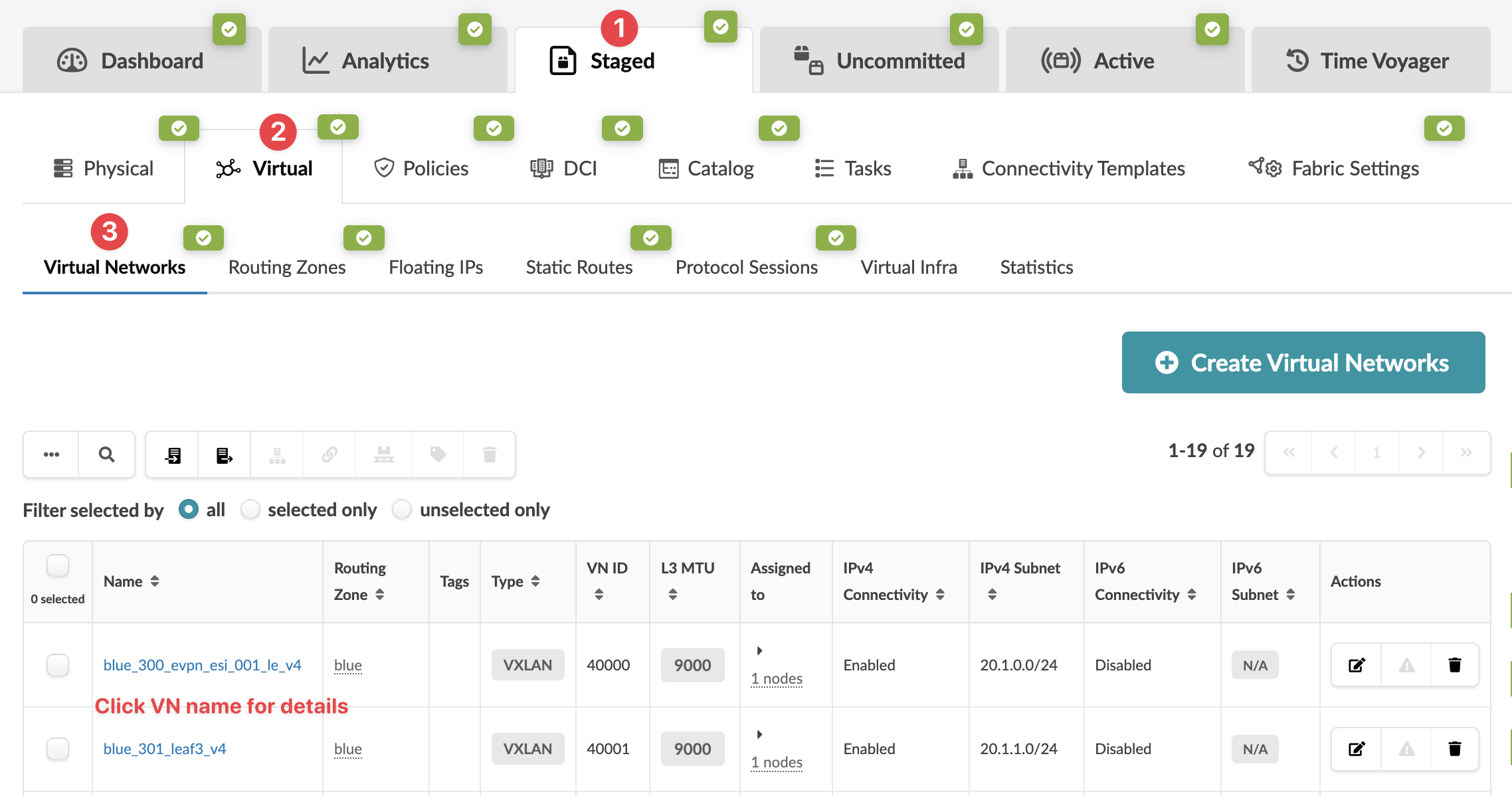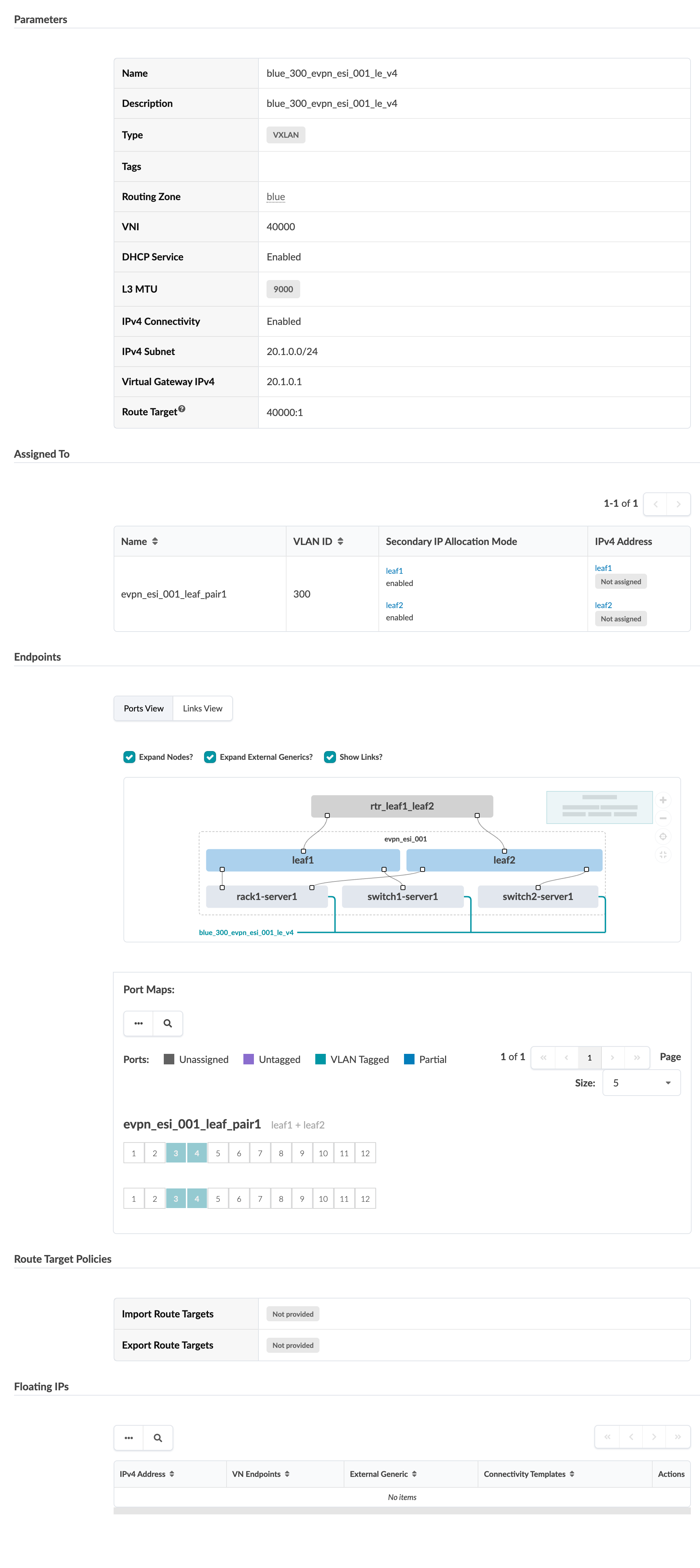- play_arrow Getting Started
- play_arrow Blueprints
- play_arrow Blueprint Analytics
- What are Blueprint Analytics
- play_arrow Dashboards
- What are Blueprint Analytics Dashboards
- Configure Auto-Enabled Blueprint Analytics Dashboards
- Instantiate Predefined Blueprint Analytics Dashboard
- Create Blueprint Analytics Dashboard
- Export Blueprint Analytics Dashboard
- Import Blueprint Analytics Dashboard
- Update Blueprint Analytics Dashboard
- Delete Blueprint Analytics Dashboard
- play_arrow Anomalies
- play_arrow Probes
- play_arrow Predefined Reports
- play_arrow Root Causes
- play_arrow Staged Freeform Blueprints
- Freeform Introduction
- play_arrow Blueprints
- play_arrow Physical
- play_arrow Selection
- play_arrow Topology
- play_arrow Systems
- Systems Introduction (Freeform)
- Create Internal System (Freeform)
- Create External System (Freeform)
- Update Assigned Config Template(Freeform)
- Update System Name (Freeform)
- Update Hostname (Freeform)
- Change Assigned Device Profile (Freeform)
- Update System ID Assignment (Freeform)
- Update Deploy Mode (Freeform)
- Add / Remove Tags on System (Freeform)
- Delete System (Freeform)
- Device Context (Freeform)
- play_arrow Links
-
- play_arrow Resource Management
- Resource Management Introduction (Freeform)
- play_arrow Blueprint Resources
- play_arrow Allocation Groups
- play_arrow Local Pools
- play_arrow Catalog (Freeform)
- play_arrow Config Templates
- play_arrow Device Profiles
- play_arrow Property Sets
- play_arrow Tags
-
- play_arrow Tasks
- play_arrow Uncommitted Blueprints
- play_arrow Active Datacenter Blueprints
- play_arrow Time Voyager (Blueprints)
- play_arrow Devices
- Device Configuration Lifecycle
- What are Managed Devices
- Add Managed Device
- Drain Device Traffic
- Upgrade Device NOS
- Device AAA
- play_arrow Device
- play_arrow Agent
- play_arrow Pristine Config
- play_arrow Telemetry
- play_arrow Apstra ZTP
- What is Apstra ZTP
- Create User Profile for Communicating with ZTP Server
- Download and Deploy Apstra ZTP Server VM
- Configure Static Management IP Address for Apstra ZTP Server
- Replace SSL Certificate for Apstra ZTP Server GUI
- Create Vendor-specific Custom Configuration
- Configure Credentials for Apstra ZTP Server GUI
- Configure Apstra Server Connection Details
- Configure DHCP Server for Apstra ZTP
- ztp.json Keys
- Configure ztp.json with Configurator
- Configure ztp.json with CLI
- Show Apstra ZTP Logs
- Onboard Devices with Apstra ZTP
- Check ZTP Status of Devices and Services
- Reset Apstra ZTP GUI Admin Password
- Authenticate User (AZTP REST API)
- play_arrow Device Profiles
- play_arrow Design
- play_arrow Logical Devices
- play_arrow Interface Maps
- play_arrow Rack Types
- play_arrow Templates
- play_arrow Config Templates (Freeform)
- play_arrow Configlets (Datacenter)
- play_arrow Property Sets (Datacenter)
- play_arrow TCP/UDP Ports
- play_arrow Tags
-
- play_arrow Resources
- play_arrow Analytics - Telemetry
- play_arrow Analytics - Flow
- play_arrow Apstra Flow Overview
- play_arrow Dashboards
- play_arrow Supported Flow Records
- play_arrow Flow Enrichment
- play_arrow Monitor Apstra Flow
- play_arrow Configuration Reference
- play_arrow API
- play_arrow Additional Documentation
- play_arrow Knowledge Base
-
- play_arrow Analytics - Exploratory Analytics
- play_arrow External Systems (RBAC Providers)
- play_arrow Providers
- play_arrow Provider Role Mapping
-
- play_arrow Platform
- play_arrow User Management
- play_arrow Security
- play_arrow External Services
- play_arrow Streaming
- Event Log (Audit Log)
- Licenses
- play_arrow Apstra VM Clusters
- play_arrow Developers
- play_arrow Technical Support
- Check Apstra Versions and Patent Numbers
-
- play_arrow Favorites & User
- play_arrow Apstra Server Management
- Apstra Server Introduction
- Monitor Apstra Server via CLI
- Restart Apstra Server
- Reset Apstra Server VM Password
- Reinstall Apstra Server
- Apstra Database Overview
- Back up Apstra Database
- Restore Apstra Database
- Reset Apstra Database
- Migrate Apstra Database
- Replace SSL Certificate on Apstra Server with Signed One
- Replace SSL Certificate on Apstra Server with Self-Signed One
- Change Apstra Server Hostname
- FIPS 140-2 Support
- play_arrow Apstra CLI Utility
- play_arrow Guides
- play_arrow References
- play_arrow Feature Matrix
- play_arrow Devices
- play_arrow Blueprint Analytics
- play_arrow Predefined Dashboards
- play_arrow Predefined Probes
- BGP Monitoring Probe
- Probe: Bandwidth Utilization
- Probe: Critical Services: Utilization, Trending, Alerting
- Probe: Device Environmental Checks
- Probe: Device System Health
- Probe: Device Telemetry Health
- Probe: Device Traffic
- Probe: Drain Traffic Anomaly
- Probe: ECMP Imbalance (External Interfaces)
- Probe: ECMP Imbalance (Fabric Interfaces)
- Probe: ECMP Imbalance (Spine to Superspine Interfaces)
- Probe: ESI Imbalance
- Probe: EVPN Host Flapping
- Probe: EVPN VXLAN Type-3 Route Validation
- Probe: EVPN VXLAN Type-5 Route Validation
- Probe: External Routes
- Probe: Hot/Cold Interface Counters (Fabric Interfaces)
- Probe: Hot/Cold Interface Counters (Specific Interfaces)
- Probe: Hot/Cold Interface Counters (Spine to Superspine Interfaces)
- Probe: Hypervisor and Fabric LAG Config Mismatch Probe (Virtual Infra)
- Hypervisor and Fabric VLAN Config Mismatch Probe
- Probe: Hypervisor MTU Mismatch Probe (Virtual Infra - NSX-T Only)
- Probe: Hypervisor MTU Threshold Check Probe (Virtual Infra)
- Probe: Hypervisor Missing LLDP Config Probe (Virtual Infra)
- Probe: Hypervisor Redundancy Checks Probe (Virtual Infra)
- Probe: Interface Flapping (Fabric Interfaces)
- Probe: Interface Flapping (Specific Interfaces)
- Probe: Interface Flapping (Specific Interfaces)
- Probe: Interface Policy 802.1x
- Probe: LAG Imbalance
- Probe: Leafs Hosting Critical Services: Utilization, Trending, Alerting
- Probe: Link Fault Tolerance in Leaf and Access LAGs
- Probe: MAC Monitor
- Probe: MLAG Imbalance
- Probe: Multiagent Detector
- Probe: Optical Transceivers
- Probe: Packet Discard Percentage
- Probe: Spine Fault Tolerance
- Probe: Total East/West Traffic
- Probe: VMs without Fabric Configured VLANs Probe (Virtual Infra)
- Probe: VXLAN Flood List Validation
- play_arrow Probe Processors
- Processor: Accumulate
- Processor: Average
- Processor: BGP Session
- Processor: Comparison
- Processor: Environment
- Processor: EVPN Type 3
- Processor: EVPN Type 5
- Processor: Extensible Service Collector
- Processor: Generic Graph Collector
- Processor: Generic Service Data Collector
- Processor: Interface Counters
- Processor: Logical Operator
- Processor: MAC
- Processor: Match Count
- Processor: Match Percentage
- Processor: Match String
- Processor: Max
- Processor: Min
- Processor: Optical Threshold
- Processor: Optical Xcvr
- Processor: Periodic Average
- Processor: Periodic Change
- Processor: Range
- Processor: Ratio
- Processor: Service Collector
- Processor: Set Comparison
- Processor: Set Count
- Processor: Standard Deviation
- Processor: State
- Processor: Subtract
- Processor: Sum
- Processor: System Utilization
- Processor: Telemetry Service Health
- Processor: Time in State
- Processor: Traffic Monitor
- Processor: Union
- Processor: VXLAN Floodlist
- Configlet Examples (Design)
- Apstra EVPN Support Addendum
- Apstra Server Configuration File
- Graph
- Juniper Apstra Tech Previews
-
What are Virtual Networks
You can create an overlay network in an Apstra blueprint by creating virtual networks (VN)s to group physically separate endpoints into logical groups. These collections of Layer 2 forwarding domains are either VLANs or VXLANs.
VLANs have the following characteristics:
- Single rack (rack-local)
- Single leaf devices or leaf pairs
- Can deploy in Layer 2-only mode (for example, isolated cluster networks for database replication)
- Can deploy with Layer 3 gateway (SVI) IP address on rack leaf, hosted with or without first-hop redundancy
VXLANs have the following characteristics:
- Fabric-wide for ubiquitous Layer 2 (inter-rack)
- Combination of single rack leaf devices or leaf pairs (MLAG)
- Can deploy in Layer 2-only mode
- Can deploy with Layer 3 gateway functionality
- The control plane selected (Pure IP Fabric or MP-EBGP EVPN) when configuring the template for your blueprint determines what is configured in the VN. (MP-EBGP EVPN provides a control plane for VXLAN routing.)
- VXLAN-EVPN capabilities for VXLAN VNs are dependent on network device makes and models.
For more information see the
evpn_support_addendum:Apstra EVPN Support Addendum.
For complete VN feature compatibility for supported Network Operating Systems (NOS), see the Apstra Feature Matrix for the applicable release (in the Reference section). For detailed capability information for a device, contact your network device vendor or Juniper Support.
VNs contain the following details:
Name | Description |
|---|---|
Name | 30 characters or fewer. Underscore, dash, and alphanumeric characters only. |
Description | The way the description is rendered in a configuration depends on the NOS of the device:
|
Type |
|
Tags | Tags |
| Routing Zone |
|
Tenant | |
| Default VLAN ID (VLAN only) |
|
| VNI(s) (VXLAN only) | Layer 2 VXLAN ID on the switch that the VN is assigned to. If left blank, it's auto-assigned from resource pools. Create up to 40 VNs at once by entering ranges or individual VNI IDs separated by commas (for example: 5555-5560, 7777). Commit the first 40 VNs before creating additional ones. |
| VLAN ID (on leaf devices) | VLAN ID |
| Reserve across blueprint (VXLAN only) | Option to use same VLAN ID on all leaf devices |
| DHCP server | Enabled/Disabled - DHCP relay forwarder configuration on SVI. Implies L3 routing on SVI |
| IPv4 Connectivity | Enabled/Disabled - for SVI routing |
| IPv4 subnet (if connectivity is enabled) |
|
| Virtual Gateway IPv4 | The IPv4 address, if enabled |
| IPv6 Connectivity | Enabled/Disabled - IPv6 connectivity for SVI routing. You must enable IPv6 in blueprint. If the template uses IPv4 spine-to-leaf link types, you can't use IPv6 in default routing zone and for VLAN type VNs. |
| IPv6 subnet (if connectivity is enabled) |
|
| Virtual Gateway IPv6 | The IPv6 address, if enabled |
| Create connectivity templates for |
|
| L3 MTU | Default value is from Virtual Network Policy. You can update the value here for these specific virtual networks. |
| Assigned to | The racks that the VN is assigned to. For more information, see table below. |
| Assigned To Details | Description |
|---|---|
Pod Name (5-stage) | 5-stage Clos networks include pods, and you can select leaf devices within each pod to extend VNs to those devices. |
Bound to | The racks assigned. For MLAG racks, the leaf pair is shown. For VLANs, if more than one rack is selected, multiple rack-local VLAN-based VNs are created. |
Tags | Leverage system tags for filtering when you create virtual networks. This helps speed-up the definition of a virtual network footprint in large-scale deployment. It nicely complements the tag-driven interface assignment at the connectivity template level. |
Link Labels | Label assigned to rack (for example, ext-link-1, single-link, single-link, ext-link-0) |
VLAN ID | Can use for batch creating VNs |
Secondary IP Allocation Mode |
|
IPv4 Address / IPv6 Address | You can set the first-hop-redundancy IP address for the SVI (VRRP, VARP and so on). If left blank, the SVI IP address is assigned from the selected pool. When you bind an EVPN connectivity template to a Layer 2 application point, the SVI IP address is used as the source / destination for the BGP session, static routes and so on. |
From the blueprint, navigate to Staged > Virtual > Virtual Networks to go to the Virtual Networks table view.

To go to the details of a virtual network, click its name in the table.

You can create, edit, import, export, tag, and delete virtual networks.





















